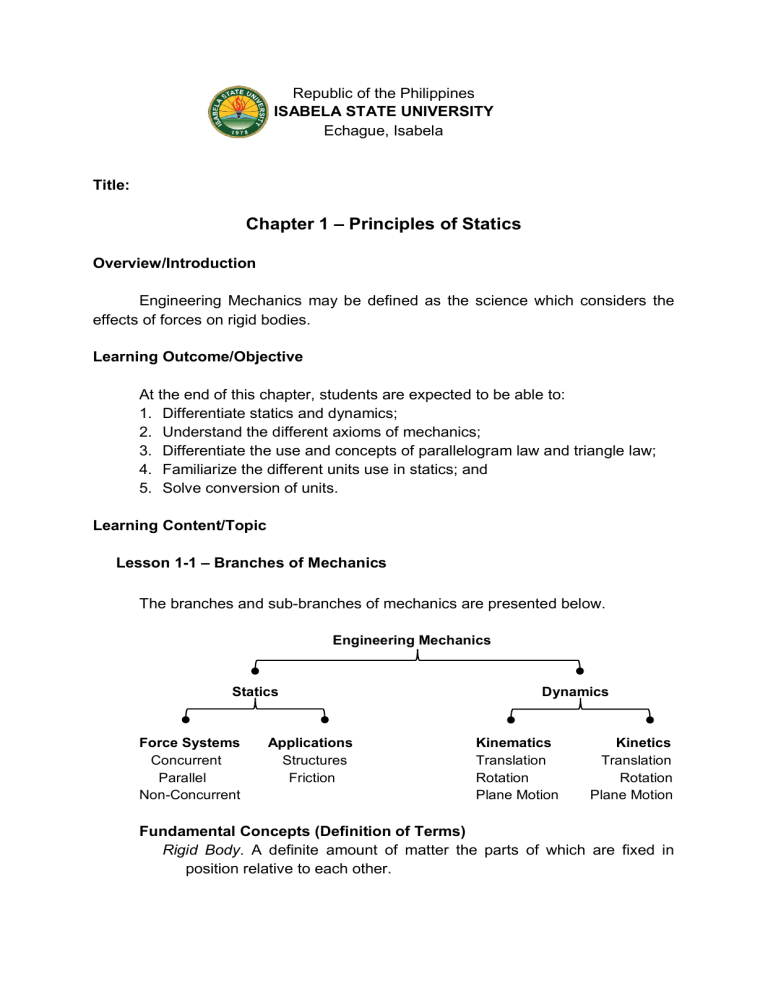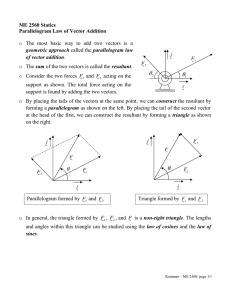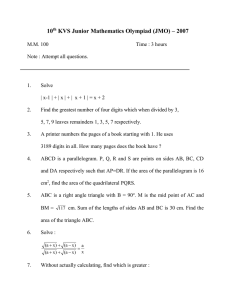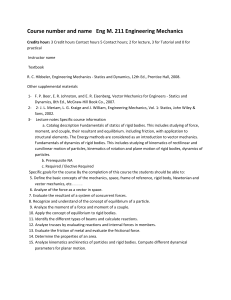
Republic of the Philippines ISABELA STATE UNIVERSITY Echague, Isabela Title: Chapter 1 – Principles of Statics Overview/Introduction Engineering Mechanics may be defined as the science which considers the effects of forces on rigid bodies. Learning Outcome/Objective At the end of this chapter, students are expected to be able to: 1. Differentiate statics and dynamics; 2. Understand the different axioms of mechanics; 3. Differentiate the use and concepts of parallelogram law and triangle law; 4. Familiarize the different units use in statics; and 5. Solve conversion of units. Learning Content/Topic Lesson 1-1 – Branches of Mechanics The branches and sub-branches of mechanics are presented below. Engineering Mechanics Statics Force Systems Concurrent Parallel Non-Concurrent Applications Structures Friction Dynamics Kinematics Translation Rotation Plane Motion Kinetics Translation Rotation Plane Motion Fundamental Concepts (Definition of Terms) Rigid Body. A definite amount of matter the parts of which are fixed in position relative to each other. Statics of Rigid Bodies. A branch of mechanics that deals with the effect and distribution of forces on rigid bodies which are and remain at rest. Dynamics of Rigid Bodies. A branch of mechanics that considers the motion of rigid bodies caused by the forces acting upon them. Force. Force may be defined as that which changes, or tends to change the state of motion of a body. Inertia. A property of matter that resist the change in motion of a body. Mass. The quantitative measure of inertia. Principle of Transmissibility. The external effect of force on a body is the same for all points of applications along its line of action. Lesson 1-2 – Axioms of Mechanics The axioms of mechanics are stated in lengthy discussion in subsequent articles. At this time we shall merely collate them for reference and state them I the following form: 1. Parallelogram Law states that the resultant of two forces is the diagonal of the parallelogram formed on the vectors of these forces. 2. Two forces are in equilibrium only when equal on magnitude, opposite in direction, and collinear in action. 3. A set of forces in equilibrium may be added to any system of forces without changing the effect of the original system. 4. Action and reaction forces are equal but oppositely directed. Lesson 1-3 – Parallelogram and Triangle Law Parallelogram Law states that the sum of the squares of the lengths of the four sides of a parallelogram equals the sum of the squares of the lengths of the two diagonals. Consider the illustration below: Y F1 F2 X Given the two forces above, the resultant or the vector sum of two forces may be can be determined by parallelogram law as shown below. Y R F2 F1 F1 F2 X Triangle Law of forces addition states that when two forces are represented as two sides of the triangle with the order of magnitude and direction, then the third side of the triangle represents the magnitude and direction of the resultant force. Y F1 F2 X Given the two forces above, the resultant or the vector sum of two forces may be can be determined by triangle law in two ways as shown below. Y R F1 F2 X Y F2 R F1 X Example Solve 1 Solve for the resultant force of the two forces shown below. Y F2 F1 X Solution A: by parallelogram law Y F1 F2 R F2 F1 X Solution B: by triangle law Y F1 R F2 X Example Solve 2 Solve for the resultant force of the three forces shown below. Y F3 F2 F1 X Solution A: by parallelogram law Step 1: Solve for the resultant of F1 and F2 and label R1 Y F1 F2 R1 F2 F1 X Step 2: Solve for the resultant of R1 and F3 Y R F3 R1 R1 F3 X Solution B: by triangle law Y F2 R F1 F3 X Lesson 1-4 – Units and Conversion Unit of Mass The common unit of mass for metric system is kilogram (kg) and gram (g) while the uncommon unit of mass in English system is slug. The unit slug is rarely used in mechanics; the unit Pound (lb) is often used. Units of Force and Weight The common units used for force are Newton (N) for metric system of unit and Pound Force (lb) for English system of unit. Newton is a combination of units of kg-m/s2. Another unit use for force in metric system is Dyne (dyn) a combination of g-cm/s2. Pound force (lb) is a English system has another unit for large forces: Kips (kip) which is equal to 1000 pound force. Units of Length The common units for length used in mechanics Meter (m) and Centimeter (cm) for metric and Feet (ft) and Inch (in) for English system. Units of Moment The unit used for moment is a combination of unit of for e and length such as Newton-Meter (Nm) and Pound-Feet (lb-ft). Units of Angle There are two common units of angle used in mechanics: Degrees and Radians. Conversion of Units Below are the equivalents of each unit in metric and English system of unit. 1m = 3.28ft 1kg = 2.204lbm 1N = 0.2248lbf 1° = 0.0175rad 1ft = 0.305m 1lbm =0.4545kg 1lbf = 4.4482N 1rad = 180°/π Example Solve 1 Convert 10kg to lbm Example Solve 2 Convert 10N to lbf Example Solve 3 Convert 10Nm to lb-ft Teaching and Learning Activities Activity 1 Answer the following questions: 1. Differentiate Statics and Dynamics. 2. Relate the axioms of mechanics to the laws of motion. 3. Convert 19lb-ft to Nm. 4. Convert 12lbm to kg.



